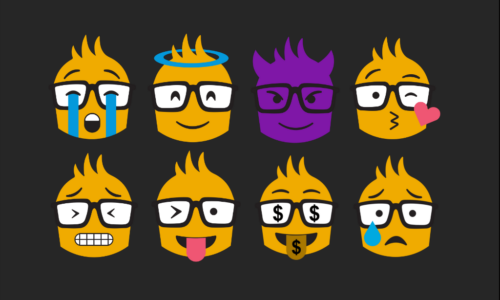Let’s Get Visual: It’s World Emoji Day

We worship our instructional designers, graphic designers, video producers, etc. Their talents can never be lauded too loudly. Where would any learning program be without the people who make the content visually captivating?
Imagery is key to engaging courses and other learning content that drives interest and retention. I don’t know anyone who prefers to click through a course made entirely of text bullet points or worse, lengthy paragraphs without any visual support to drive home the concepts or reinforce the information graphically.
There’s a power to graphical expression that can’t be put into words. Maybe this is why we all love emojis. One needs no design talent to share in the joy of using images to capture a feeling. And feeling is the apt word because that’s what’s at the heart [insert heart emoji] of emoticons: emotion.
When you want to message a colleague: “I’m totally rolling my eyes right now” in the middle of a meeting or “Wow, that’s a smokin’ hot idea,” but writing it seems really cheesy – thank goodness for emojis! With a click we can show how we feel. In some cases, they can communicate more succinctly than language and have been described as the hieroglyphics of our time. A picture still says a thousand words – even a silly, little cartoon picture.
July 17 is World Emoji Day.
This weekend we can raise a glass (and text a grinning face or two) in honor of World Emoji Day on July 17. But why, you ask? What’s the significance of that date?
It’s actually a fun, little, techy fact:
Apple’s calendar emoji shows July 17 to mimic their Calendar (iCal) app which shows the same date, which was in turn was chosen because iCal was introduced at the Macworld Expo on July 17, 2002.
Now, most of the Calendar icons across platforms (Google, Twitter, etc.) feature that date, as well. It’s become a bit of an inside joke.
But to be serious, sometimes it is the little things (literally) in life that make things more fun – an itsy-bitsy car (I’ve owned three MINIs and now a FIAT 😊), miniature cupcakes, travel sizes of anything, airplane booze bottles, a dog that fits in your purse. I’d put emoticons into this category. They’re so tiny and yet so bigtime. Nothing says “that’s hilarious” better than the Face with Tears of Joy emoji, which is also apparently the most popular.
Also, emojis rescued us all from over-acronymizing ourselves into a cryptic oblivion – LOLing and ROFLing endlessly like languageless robots. OMG, IDK but ATM SMH – IMHO, not gr8. TMI? I’d rather just drop a solid Woman Shrugging icon.
Back to Learning Life, Back to the Imagery
How does this all circle back to learning? Beyond the importance of visuals in your training as stated above and which I’m sure hardly anyone would dispute, emojis themselves can actually be used in your trainings. They can be a useful tool for learners to express themselves and for you to create more visually interesting content.
Some simple ideas in honor of World Emoji Day:
- Allow emojis to be used in feedback / surveys on content
- In social eLearning settings, let learners use them with each other
- Use emojis to section off content or support a module title
- Add visual accent to bullets to reinforce each point
We’d be happy to hear if you’re using emojis in your training and how so. Please share your best practices if you have them, punctuated by an emoji, of course.




